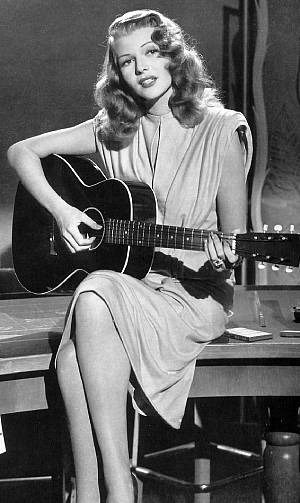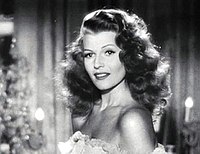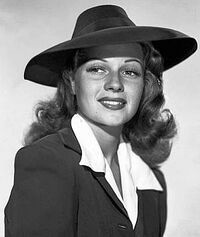Reda Kazan: Difference between revisions
mNo edit summary |
mNo edit summary |
||
| Line 27: | Line 27: | ||
| genre = {{flatlist| | | genre = {{flatlist| | ||
* {{wpl|Folk music|Folk}} | * {{wpl|Folk music|Folk}} | ||
* | * [[Gylian jazz|jazz]] | ||
* {{wpl|cabaret}} | * {{wpl|cabaret}} | ||
* {{wpl|pop music|pop}} }} | * {{wpl|pop music|pop}} }} | ||
| Line 57: | Line 57: | ||
Reda's primary instrument was the acoustic guitar. She tuned her guitar to {{wpl|Open C tuning|Open C}}. She generally avoided {{wpl|fingerpicking}} in favour of vigorous {{wpl|rhythm guitar}}. | Reda's primary instrument was the acoustic guitar. She tuned her guitar to {{wpl|Open C tuning|Open C}}. She generally avoided {{wpl|fingerpicking}} in favour of vigorous {{wpl|rhythm guitar}}. | ||
Most of her songs were in a folk style, and she sometimes incorporated influences from {{wpl|cabaret}}, {{wpl|music hall}}, | Most of her songs were in a folk style, and she sometimes incorporated influences from {{wpl|cabaret}}, {{wpl|music hall}}, [[Gylian jazz|jazz]], and {{wpl|blues}}. | ||
Reda's lyrics were the main attraction of her songs: witty, satirical, and bawdy. Their effect was completed by her deadpan delivery and fondness for unexpectedly filthy language. She wrote mainly in her native Hellene, [[Gylic languages|Yaskan and Rezakan]], with abundant {{wpl|code-switching}} and isolated words from other Gylic languages. She also performed in English and French on occasion, with a thick accent. | Reda's lyrics were the main attraction of her songs: witty, satirical, and bawdy. Their effect was completed by her deadpan delivery and fondness for unexpectedly filthy language. She wrote mainly in her native Hellene, [[Gylic languages|Yaskan and Rezakan]], with abundant {{wpl|code-switching}} and isolated words from other Gylic languages. She also performed in English and French on occasion, with a thick accent. | ||
Revision as of 09:14, 15 February 2020
Reda Kazan | |
|---|---|
 Reda Kazan, pictured during a performance in 1946 | |
| Born | Reðe Kazansides 18 October 1918 Arlyka, Xevden |
| Died | 9 January 1991 (aged 72) Velouria, Nerveiík-Iárus-Daláyk, Gylias |
| Nationality | Gylian |
| Occupation |
|
| Years active | 1938–1991 |
| Children | Penny Kazan |
| Musical career | |
| Genres | |
| Instruments |
|
Reda Kazan (Hellene reformed: Rέδα Καζάɴ; 18 October 1918 – 9 January 1991) was a Gylian singer, songwriter, dancer, actress, and hétaïre. She was an iconic figure of the Liberation War, becoming one of its most successful entertainers.
Reda's music combined simple guitar techniques with defiant lyrics, steeped in ribaldry and gallows humour. She toured the Free Territories intensely during the war, and was popular with both People's Army soldiers and civilians. She also acted in a series of films that capitalised on her glamorous sex symbol persona, particularly her celebrated collaborations with Ellen Powell that showcased their dance talents.
Reda's association with the war reduced her audience after its end, but her career continued. She trained as an hétaïre, performed regularly as a nightclub act, and continued to work as an actress, coming to be associated with elegant rake characters. Diagnosed with Alzheimer's disease, she helped draw attention to the disease, before undergoing voluntary euthanasia in 1991.
Early life
She was born Reðe Kazansides (Hellene reformed: Ρέδε Καζαɴςίδες) on 18 October 1918 in Arlyka, a village in the Salxar mountains. Her mixed Hellene–Gylic descent is reflected in her name; she identified foremost as Hellene throughout her life.
Her parents were travelling entertainers. The family was poor, and she did not attend school. She learned to read and write from her parents, but found it difficult. She was functionally illiterate into her teenage years, and remained dyslexic as an adult. She began learning to play the guitar and dance at an early age, and started performing with her parents.
The family's peripatetic existence both gave her abundant time to practice, while the disreputable milieu they lived in would shape her public persona. She admired Madame Rouge growing up, and modelled her personality and writing style after her. She gave her first solo performance at 18, when her parents were arrested before a scheduled concert. She went through with the show and used her payment to pay her parents' bail.
Liberation War
Reda said the family was "in the right place and right time" when the Liberation War began: the area initially captured by the People's Army. The initial experience of authoritarian socialism disgusted Reda, and she welcomed the proclamation of the Free Territories.
She continued to perform professionally, while her parents worked on the home front and supported her career. She simplified her stage name to "Reda Kazan" — her first name now mirroring her own pronunciation. She found her voice as a songwriter and assumed the persona of a Madame Rouge-styled decadent temptress.
Throughout the war, Reda toured the Free Territories, performing for soldiers and civilians alike wherever she could. Her insistence on performing at the front lines was both reckless and brave, and won her admiration. In between touring, she maintained a busy schedule: recording songs, acting in films, and appearing on radio broadcasts and comedy programs. This cemented her association with wartime entertainment.
Musical style
Reda's primary instrument was the acoustic guitar. She tuned her guitar to Open C. She generally avoided fingerpicking in favour of vigorous rhythm guitar.
Most of her songs were in a folk style, and she sometimes incorporated influences from cabaret, music hall, jazz, and blues.
Reda's lyrics were the main attraction of her songs: witty, satirical, and bawdy. Their effect was completed by her deadpan delivery and fondness for unexpectedly filthy language. She wrote mainly in her native Hellene, Yaskan and Rezakan, with abundant code-switching and isolated words from other Gylic languages. She also performed in English and French on occasion, with a thick accent.
Her war-themed songs used sarcastic lyrics and boisterous performance to convey a spirit of defiant determination. One of the best examples is "Soldier's Song", whose verses deliver a motor-mouthed litany of the indignities of military service before culminating in a rousing, profanity-laden chorus that ironically asserts how great it is to be a soldier. Other songs used sharp humour to condemn the brutality of war, such as "My Friend, the Grenade Launcher", and "First We Kill Everyone, Then We'll Have Peace".
Her sexually-oriented material saw her play the part of an irresistible worldly seductress to the hilt, with tongue in cheek. Themes ranged from the unapologetic pride of promiscuity to parodying the anxieties of whether romantic relationships would survive the separation caused by military service.
Reda also wrote straightforward comedic songs, where she could show off her storytelling and wordplay abilities. Apart from her songs, she performed covers of folk songs, sea shanties, and contemporary blues and novelty songs. She wrote musical adaptations of poems by Madame Rouge and Phaedra Metaxa; the two became close friends as a result, and Phaedra even wrote poems specifically for her to sing.
She avoided ballads and torch songs, finding them sentimental and inappropriate for soldiers. In a 1946 interview, she said:
"I think the last thing somebody wants to hear after a day of shooting, tank blasts, artillery, triage, and death stalking your every moment is some music hall nonsense written by a recruiting sergeant, or something to cry over how you left your loved ones at home."
Performance
Reda's shows included music, dance, and comedy. She accompanied herself on guitar for her own performances, and used either other musicians or gramophone recordings for her dance segments.
She had a mischievous stage presence. She playfully winked to punctuate certain lines, bantered with the audience between songs, and introduced songs with humorous anecdotes and double entendres.
During her dance segments, she would go into the audience and pick random members on the spot to serve as her partners.
Acting
Reda acted in a series of Free Territories films. Most were recorded with a low budget and an experimental approach, contrasting with her classical glamour.
She quickly settled into a niche of playing good-hearted femme fatale characters, alluring seductresses who did the right thing while enjoying their "wicked" behaviour.
She acted in many musical films, which were best suited for showcasing her singing and dancing skills. Her collaborations with Ellen Powell were the most critically acclaimed, displaying their complementary dance talents and hearty sexual chemistry.
An unexpected benefit for her film career was that, due to the infusion of Alscian expertise into the Free Territories' film industry, the majority of her surviving films were made with early colour techniques. This made them easier to later restore using colour recovery and more naturalistic processing.
Image
Reda used her public persona as an ideal that would inspire her audience. She had a glamorous appearance and always appeared well-dressed. In the context of wartime rationing, this meant she and her parents devoted great inventiveness, prudence, and effort to maintaining her wardrobe and cosmetics.
Her public image was defined by androgynous-looking vêtements utilitaires. She favoured skirt suits because they were easy to wear and maintain, often donned white gloves for their elegant effect, and almost always wore hats. She considered the latter the most important part of her wardrobe. Several of her films drew humour by implying she was less attractive without them.
She jokingly expressed a desire to retain the standards of appearance created during the war, quipping, "Are we fighting a war here just so anyone can just roll out of bed and right out in public?"
"Wickedness" was important to Reda's status as a sex symbol. She once played up her sultry image by appearing in a series of portraits that depicted her as spoiled, pretending to be annoyed at receiving gifts or being admired and kissed by fans. These photos emphasised the roguish charm of her persona, and added to her sex appeal as intended.
Post-war
Reda was present in Velouria when the proclamation of Gylias took place on 2 January 1958. Upon hearing the proclamation, she exclaimed, "Finally, I'll never have to sing 'My Friend, the Grenade Launcher' again!".
She remained active as a musician and actress after the war. However, she was so closely associated with it that most of her audience moved on, leaving a smaller but devoted following.
The emergence of modern rock and pop in the 1960s cemented the perception of her musical style as outdated. She was sanguine about these developments, remarking in 1963, "Everyone has their day in the sun. Every day has to end too, so I can't complain that mine has."
She worked as a session musician, and mainly as a nightclub act and cabaret performer in small venues. Her show was much the same as before, but her repertoire now excluded her war songs. Although remaining wedded to her guitar-and-voice approach, her style evolved somewhat from the 1960s on, incorporating bossa nova and samba influences, as well as showcasing her new skill at fingerpicking.
Reda continued to appear on screen, although in smaller roles than before. Her character type increasingly evolved towards an impeccably-dressed, ageing libertine, having lost none of her charm but having grown more comically perverted with age.
Several Groovy Gylias figures paid tribute to Reda's career and influence. She appeared in several Brigitte Nyman and Alike Demetriou films, usually playing their mothers, and created several well-received duets and dance sequences with them.
She was one of many famous people to appear on the cover of The Beaties' Sgt. Pepper's Lonely Hearts Club Band, and starred in Magical Mystery Tour as Meja Ståblom's "dirty old aunt".
Having met Maléna Laryn in the late 1960s, Reda trained and became a practicing hétaïre. The profession was excellently-suited to her glamorous image and lengthy career as an entertainer. As an hétaïre, she eschewed the 19th century-inspired appearance of the profession in favour of her own Levystile suits, feeling that people were sufficiently familiar with her musical and cinema career to make cultivating mystique impossible.
Later life
Reda enjoyed something of a rediscovery among younger audiences during the 1980s. She was a distinguished guest at the 30th anniversary of the Liberation War's end in 1988, invited by the Filomena Pinheiro government. At the anniversary, she performed her war songs in public for the last time.
Capitalising on the renewed attention, she released the retrospective box set The Woman Who Won The War in 1989. Compiled with the assistance of Radix magazine, it collected the best 1938–1958 live performances of her songs, digitally remastered. She wanted to call it The Woman Who Won The War... And Lost The Peace, but was dissuaded by her contributors, and used the shorter title to highlight her accomplishments while keeping the irony implicit. The set was critically acclaimed and one of her best-distributed releases in years.
Reda's health began to decline in the 1980s. She sometimes had trouble remembering lyrics and her speeches between songs began to ramble. She was diagnosed with Alzheimer's disease in early 1983. She publicly announced her diagnosis and talked frankly about it, helping draw attention to a previously obscure disease.
She took up painting to cope with Alzheimer's, and strove to remain intellectually active after her diagnosis, continuing her hétaïre and musical work. She donated prolifically to medical research.
Death
Feeling that her disease was progressing and unwilling to experience a loss of mental faculties, Reda chose to undergo voluntary euthanasia. Having spent her last year putting her affairs in order and saying goodbye to friends and loved ones, Kazan was euthanised at a Velouria clinic on 9 January 1991, aged 72.
She chose to orally consume a lethal dose of secobarbital, so as to symbolically triumph over her disease. Her last statement before taking the dose was that she wanted her last words to be, "I am, thank the gods, a Gylian."
She was cremated in accordance with her last wishes, and her ashes scattered in the Salxar mountains near Arlyka.
Legacy
Reda remains one of the most famous figures of the Liberation War and Free Territories culture, and her wartime songs have gained modern appreciation for their lyrical quality, seen as capturing the defiant and rebellious spirit of the Free Territories. Her contribution to soldiers' morale was honoured by the Veterans for a Just Peace and other post-war figures, including defense minister Ann Harman and Prime Minister Filomena Pinheiro.
Her movies with Ellen Powell are considered among the pinnacle of Gylian musical comedies. Haruka Morishima cited their soundtrack style as an inspiration specifically for the Beaties' "Honey Pie".
Although she lost most of her audience due to the "rock revolution", Reda remained familiar to subsequent generations for her on-screen work. Her public image as a glamorous and "wicked" seductress made her a sex symbol and influenced others, including Rauna Næsve and The Case of the Facts's lead character advocate Mitsuki, for whom Esua Nadel specifically drew on Reda's later image as an impeccably-dressed, perverted rake.
Private life

Reda called herself bisexual. Throughout her career, she had a string of relationships and one-night stands, which stabilised in later life as her hétaïre work led her to provide companionship to long-term paying clients. Her notable partners included poet Phaedra Metaxa, writer Anaïs Nin, and her co-star Ellen Powell.
She married Gauchic artist Lucien Couturier in 1958, when she was 40 and he was 27. They remained married until her death. They had an open marriage, agreeing they could both have sexual relations outside the marriage, and at times even recommended partners to each other.
She had one daughter, Panorea Kazansides (b. 1949), better known as "Penny". The two were very close in life: Penny followed Reda's career path as an hétaïre, arranged for her care in her last years, and was present at her deathbed.
Penny wrote her mother's biography, published in 1993, contributed home movies of Reda to a documentary about art therapy and Nation Building, and helped bring her works to Proton. Her work as the executor of Reda's estate led to a friendship with Kizette Łempicka.



